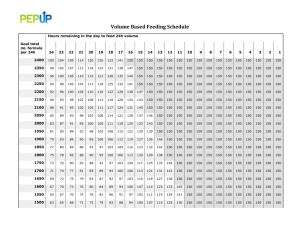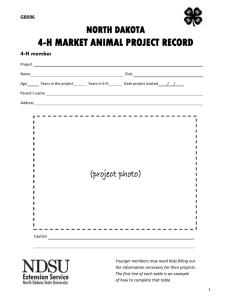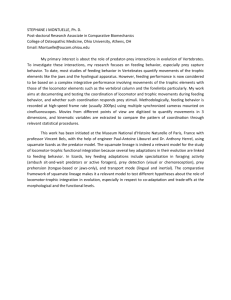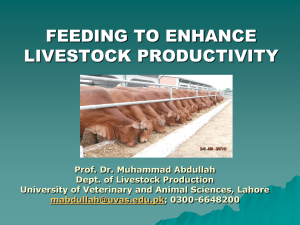Feeding Period Sheet - North Dakota State University
advertisement
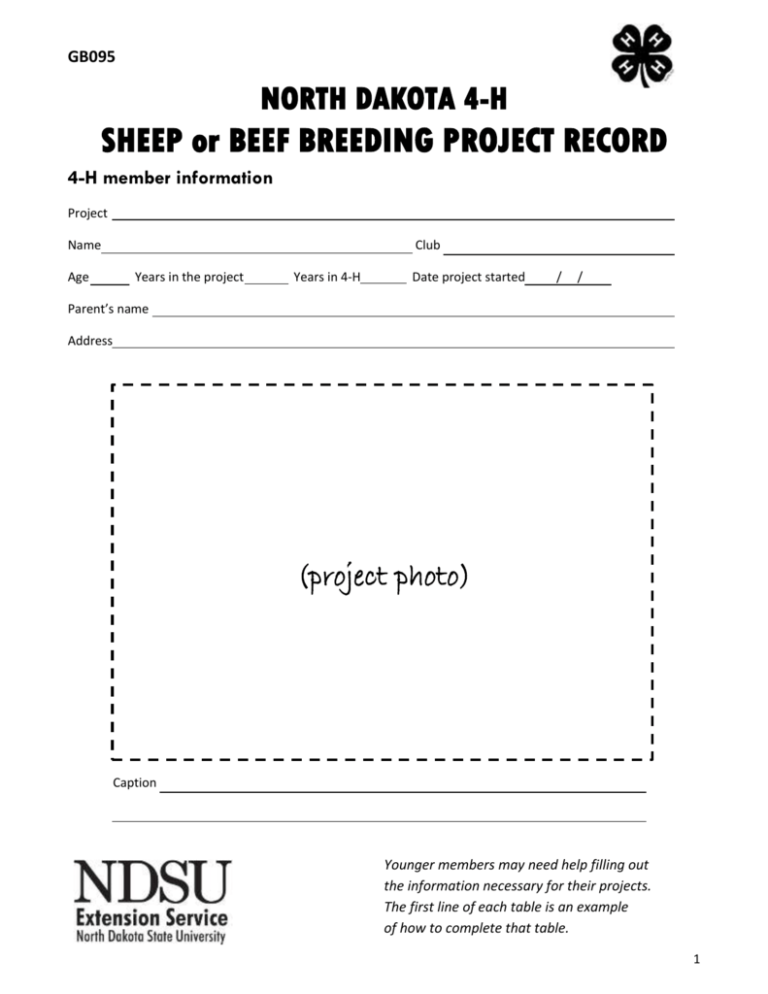
GB095 NORTH DAKOTA 4-H SHEEP or BEEF BREEDING PROJECT RECORD 4-H member information Project Name Age Club Years in the project Years in 4-H Date project started / / Parent’s name Address (project photo) Caption Younger members may need help filling out the information necessary for their projects. The first line of each table is an example of how to complete that table. 1 Objectives In the market animal project, you will learn: 1. To gain a knowledge and understanding of livestock production and feeding. 2. To make decisions and be responsible for the care and wellbeing of an animal. You may not reach all of your objectives in one year. You may develop additional objectives to fit your needs. 3. To learn how to manage time and resources. 4. To share the information and skills learned with others. 5. To learn how to communicate with others. 6. To explore careers which work with animals. My objectives for my breeding project: 11. 12. Breeding Project Information (Fill in the following information where applicable) Number of years in market project Number of animals in market project Number of: Heifers Ewes Cows Lambs Calves Rams Bulls Goals of this project How many animals in this project will you be exhibiting at Achievement Days or your county fair? 2 Feeding Period Sheet 1. Date feeding period started ended 2. Total days of this feeding period 3. Check the type of animal that this feeding period applies to: ☐ Heifers ☐ Cows ☐ Calf ☐ Bull ☐ Ewes ☐ Lambs ☐ Rams 4. Animal weight at the beginning of feeding period (use average weight if more than one animal) In this section, include all feeds, minerals, vitamins and protein supplements. If you are feeding more than one animal the same ration, use one feed sheet. Do not include animals that are on different rations. Use a separate set of feeding period sheets for those animals. Feed (A) Lbs. Feed per Day (B) Cost/lb. of Feed (C) No. of Days Fed (D) Total lbs. Fed (E) Total Cost Grass Hay 24 2.5₵/lb. 120 2800 72.00 XXXXX XXXXX Totals (A) (D) $ (E) Explain why this ration was used Explain why any changes in this ration were made (When major changes in ration occur, please document on the next feeding period sheet. You may need extra sheets.) 3 Feeding Period Sheet 1. Date feeding period started ended 2. Total days of this feeding period 3. Check the type of animal that this feeding period applies to: ☐ Heifers ☐ Cows ☐ Calf ☐ Bull ☐ Ewes ☐ Lambs ☐ Rams 4. Animal weight at the beginning of feeding period (use average weight if more than one animal) In this section, include all feeds, minerals, vitamins and protein supplements. If you are feeding more than one animal the same ration, use one feed sheet. Do not include animals that are on different rations. Use a separate set of feeding period sheets for those animals. Feed (A) Lbs. Feed per Day (B) Cost/lb. of Feed (C) No. of Days Fed (D) Total lbs. Fed (E) Total Cost Grass Hay 24 2.5₵/lb. 120 2800 72.00 XXXXX XXXXX Totals (A) (D) $ (E) Explain why this ration was used Explain why any changes in this ration were made (When major changes in ration occur, please document on the next feeding period sheet. You may need extra sheets.) 4 Feeding Period Sheet 1. Date feeding period started ended 2. Total days of this feeding period 3. Check the type of animal that this feeding period applies to: ☐ Heifers ☐ Cows ☐ Calf ☐ Bull ☐ Ewes ☐ Lambs ☐ Rams 4. Animal weight at the beginning of feeding period (use average weight if more than one animal) In this section, include all feeds, minerals, vitamins and protein supplements. If you are feeding more than one animal the same ration, use one feed sheet. Do not include animals that are on different rations. Use a separate set of feeding period sheets for those animals. Feed (A) Lbs. Feed per Day (B) Cost/lb. of Feed (C) No. of Days Fed (D) Total lbs. Fed (E) Total Cost Grass Hay 24 2.5₵/lb. 120 2800 72.00 XXXXX XXXXX Totals (A) (D) $ (E) Explain why this ration was used Explain why any changes in this ration were made (When major changes in ration occur, please document on the next feeding period sheet. You may need extra sheets.) 5 Grazing Period Sheet for Pasture 1. Date grazing period started ended In this section include grazing only. All mineral, vitamin and protein supplements should be recorded on Feed Period Sheets. Kind of Animal (A) Number of Animals (B) Equiv. (see table) (C) Animal Units (A x B) (D) Months Grazed (E) Total AUMs Grazing (C x D) (F) Cost/AUM (G) Grazing Cost/Period (E x F) Heifer 1 .65 .65 6 3.90 12.50 48.75 2. Totals (A) (B) (C) XXXXX (E) $ (F) $ (G) Table 1. Animal unit equivalent conversion factor. Kind of Animal Beef cow 2 years and over Calves over 3 months Yearling cattle Bulls Ewes Yearling sheep Rams Animal Unit Conversion Factor 1.0 0.3 0.65 1.3 0.2 0.1 0.25 AUM – Animal Unit Month is the amount of feed or forage required by an animal for one month. Animal Unit – A mature (1,000 lb.) cow and calf or the equivalent based on an average daily forage consumption of 26 pounds of dry matter per day. 6 Loan Record To determine interest paid: A x B x C ÷ 365 Date Item Loan was Received For (A) Amount of Loan 1-1-07 Heifer 600.00 .10 4 yrs. XXXXX XXXXX XXXXX 1. Totals (B) (C) % Length of Interest Loan (D) Principle Paid (E) Interest Paid (F) Total Payment 150.00 60.00 450.00 $ (D) $ (E) XXXXX Travel Expense Animal Identification Event (A) Entry Fees 2324 County fair - 2. Totals $ (A) (B) Transportation (C) Lodging (D) Other (E) Totals a+b+c+d 20.00 - - 20.00 $ (B) $ (C) $ (D) $ (E) 7 Equipment Inventory Equipment purchases made in previous years Date Item Estimated Value at Beginning of Project Year (A) 6-1-07 Show stick 12.00 $ 1. Totals Estimated Value at End of Project Year (B) Depreciation Value* 10.00 2.00 (A) $ (B) $ (C) Equipment purchases made in current project year Date Item Price Paid 6-1-07 Clipper 150.00 2. Totals $ (A) Animal Inventory Date Item Estimated Value at Beginning of Project Year (A) 1-3-07 Steer calf 250.00 1. Totals $ Estimated Value at End of Project Year (B) Change Inventory (C)* 560.00 310.00 (A) $ (B) $ (C) * Depreciation value or inventory change value = beginning value (column A) minus ending value (column B) 8 Expense Summary Value of animals at beginning of this year’s project (use one line per animal in project) Animal Identification No. (A) Beginning Weight (B) Market Price at Time of Purchases (C) Animal Value (D) (B x C) 2425 600.00 .83/cwt 498.00 1. TOTAL COLUMN D $ 2. Veterinary expenses (from health section); use current project year expenses only .........................................................................$ 3. Total feed bill (total all feeding period sheets – line 5E from feeding period sheets) .............................................................................. $ 4. Interest (from loan record section, line 1E) .............................................................. $ 5. Travel expense (travel expense section, line 2E) ....................................................... $ 6. Equipment purchases (from equipment inventory section, line 2A); use current project year purchases only ....................................................................... $ 7. Other cash expenses ................................................................................................. $ Specify Specify 8. Total cash expenses (add lines 1 + 2 + 3 + 4 + 5 + 6 + 7) ........................................... $ 9 Income Summary Premiums from livestock shows (for current project year, use actual ribbon premiums) Date Show/Event Ribbons and/or Placing Actual Premiums 1-1-07 State fair Blue ribbon 25.00 1. Total from livestock premiums .................................................................................... $ Estimate or actual sale value of project at end of project year Animal ID Weight Selling Time (A) Market Price Selling Time (B) Sale Value* A x B (C) 3751 650 .86/cwt 559.00 2. Total sale value of project (total of column C) ....................................................... $ *sale value = selling weight multiplied by selling market price If animal is sold by the head, enter value in sale value, column C 3. Other cash income received from your project ...................................................... $ Specify Specify Specify 4. Total cash income (add lines 1 + 2 + 3 + 4) ............................................................... $ 10 Business Summary 1. Total cash income (from income section, line 4) ..................................................... $ 2. Total cash expense (from expense section, line 8) .................................................. $ 3. Net cash income or loss (line 1 minus line 2) ........................................................... $ 4. Value of any feed left on hand for which you have paid ......................................... $ 5. Net income – profit or loss (line 3 + 4) .................................................................... $ Explain why you have a profit or loss How will you improve this project? 11 Suggested Companion Projects National 4-H Curriculum Veterinary Science Series From Airedales to Zebras, Unit 1 All Systems Go, Unit 2 On the Cutting Edge, Unit 3 Beef Series Bite Into Beef, Unit 1 Here’s the Beef, Unit 2 Leading the Charge, Unit 3 Sheep Series Lambs, Rams and You, Unit 1 Shear Delights, Unit 2 Leading the Flock, Unit 3 Developed by Annette Steffan, former county Extension agent Chuck Steffan, former area beef/range management specialist Dan Dhuyvetter, former area beef/range management specialist For more information on this and other topics, see: www.ag.ndsu.edu This publication may be copied for noncommercial, educational purposes in its entirety with no changes. Requests to use any portion of the document (including text, graphics or photos) should be sent to NDSU.permission@ndsu.edu. Include exactly what is requested for use and how it will be used. North Dakota State University does not discriminate on the basis of race, color, national origin, religion, sex, disability, age, Vietnam Era Veterans status, sexual orientation, marital status, or public assistance status. Direct inquiries to the Chief Diversity Officer, 205 Old Main, (701) 231-7708. County Commissions, NDSU and U.S. Department of Agriculture Cooperating. This publication will be made available in alternative formats for people with disabilities upon request, (701) 231-7881. 05/07 Revised 02/11 12


